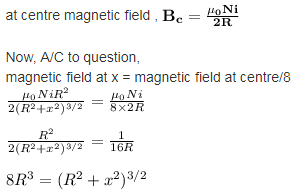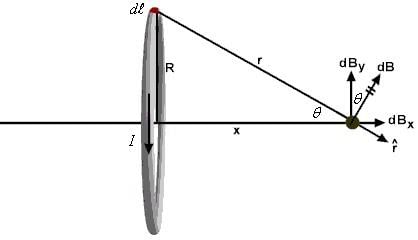Class 12 Exam > Class 12 Questions > A circular coil of radius r carries current I...
Start Learning for Free
A circular coil of radius r carries current I. The magnetic field at its center is B. at what distance from the center on the axis of the coil magnetic field will be B/8
- a)√3R
- b)√2R
- c)2R
- d)3R
Correct answer is option 'A'. Can you explain this answer?
Verified Answer
A circular coil of radius r carries current I. The magnetic field at i...
As you know that magnetic field at point on the axis of current carrying ring is


where x is the point on the axis of ring, R is the radius of ring , i is the current carrying on ring and N is the number of turns .

This is possible only when x = +-√3R
Hence, √3R distance from the centre magnetic field is equal to magnetic field at centre .


Most Upvoted Answer
A circular coil of radius r carries current I. The magnetic field at i...

Free Test
FREE
| Start Free Test |
Community Answer
A circular coil of radius r carries current I. The magnetic field at i...
Introduction:
The question asks us to find the distance from the center of a circular coil on the axis of the coil where the magnetic field will be B/8. We are given that the coil has a radius of r and carries a current of I. The magnetic field at the center of the coil is B.
Explanation:
To solve this problem, we can make use of the formula for the magnetic field at the center of a circular coil, which is given by:
B = μ₀ * I / (2 * R)
where B is the magnetic field, μ₀ is the permeability of free space, I is the current, and R is the radius of the coil.
We are given that the magnetic field at the center is B. We need to find the distance from the center on the axis of the coil where the magnetic field will be B/8.
Step 1: Finding the magnetic field at the desired distance:
Let's assume that the distance from the center on the axis of the coil where the magnetic field is B/8 is x.
At this distance, the magnetic field can be calculated using the formula for the magnetic field on the axis of a circular coil, which is given by:
B' = μ₀ * I * R² / (2 * (R² + x²)^(3/2))
where B' is the magnetic field at the desired distance, μ₀ is the permeability of free space, I is the current, R is the radius of the coil, and x is the distance from the center on the axis of the coil.
Step 2: Equating the magnetic fields:
We can now equate the magnetic field at the center of the coil (B) to the magnetic field at the desired distance (B') and solve for x:
B = B'
μ₀ * I / (2 * R) = μ₀ * I * R² / (2 * (R² + x²)^(3/2))
Simplifying this equation, we get:
1 / R = R / (R² + x²)^(3/2)
Cross-multiplying and rearranging, we get:
(R² + x²)^(3/2) = R²
Taking the square root of both sides, we get:
R² + x² = R^(4/3)
Substituting x = 3R, we get:
R² + (3R)² = R^(4/3)
Simplifying this equation, we get:
R^(4/3) = 10R²
Taking the cube root of both sides, we get:
R^(4/3) = R^(2/3) * 10^(2/3)
Simplifying this equation, we get:
R^(2/3) = 10^(2/3)
Taking the cube of both sides, we get:
R^2 = 100
Taking the square root of both sides, we get:
R = 10
Therefore, the correct answer is option A) 3R.
The question asks us to find the distance from the center of a circular coil on the axis of the coil where the magnetic field will be B/8. We are given that the coil has a radius of r and carries a current of I. The magnetic field at the center of the coil is B.
Explanation:
To solve this problem, we can make use of the formula for the magnetic field at the center of a circular coil, which is given by:
B = μ₀ * I / (2 * R)
where B is the magnetic field, μ₀ is the permeability of free space, I is the current, and R is the radius of the coil.
We are given that the magnetic field at the center is B. We need to find the distance from the center on the axis of the coil where the magnetic field will be B/8.
Step 1: Finding the magnetic field at the desired distance:
Let's assume that the distance from the center on the axis of the coil where the magnetic field is B/8 is x.
At this distance, the magnetic field can be calculated using the formula for the magnetic field on the axis of a circular coil, which is given by:
B' = μ₀ * I * R² / (2 * (R² + x²)^(3/2))
where B' is the magnetic field at the desired distance, μ₀ is the permeability of free space, I is the current, R is the radius of the coil, and x is the distance from the center on the axis of the coil.
Step 2: Equating the magnetic fields:
We can now equate the magnetic field at the center of the coil (B) to the magnetic field at the desired distance (B') and solve for x:
B = B'
μ₀ * I / (2 * R) = μ₀ * I * R² / (2 * (R² + x²)^(3/2))
Simplifying this equation, we get:
1 / R = R / (R² + x²)^(3/2)
Cross-multiplying and rearranging, we get:
(R² + x²)^(3/2) = R²
Taking the square root of both sides, we get:
R² + x² = R^(4/3)
Substituting x = 3R, we get:
R² + (3R)² = R^(4/3)
Simplifying this equation, we get:
R^(4/3) = 10R²
Taking the cube root of both sides, we get:
R^(4/3) = R^(2/3) * 10^(2/3)
Simplifying this equation, we get:
R^(2/3) = 10^(2/3)
Taking the cube of both sides, we get:
R^2 = 100
Taking the square root of both sides, we get:
R = 10
Therefore, the correct answer is option A) 3R.

|
Explore Courses for Class 12 exam
|

|
Question Description
A circular coil of radius r carries current I. The magnetic field at its center is B. at what distance from the center on the axis of the coil magnetic field will be B/8a)√3Rb)√2Rc)2Rd)3RCorrect answer is option 'A'. Can you explain this answer? for Class 12 2025 is part of Class 12 preparation. The Question and answers have been prepared according to the Class 12 exam syllabus. Information about A circular coil of radius r carries current I. The magnetic field at its center is B. at what distance from the center on the axis of the coil magnetic field will be B/8a)√3Rb)√2Rc)2Rd)3RCorrect answer is option 'A'. Can you explain this answer? covers all topics & solutions for Class 12 2025 Exam. Find important definitions, questions, meanings, examples, exercises and tests below for A circular coil of radius r carries current I. The magnetic field at its center is B. at what distance from the center on the axis of the coil magnetic field will be B/8a)√3Rb)√2Rc)2Rd)3RCorrect answer is option 'A'. Can you explain this answer?.
A circular coil of radius r carries current I. The magnetic field at its center is B. at what distance from the center on the axis of the coil magnetic field will be B/8a)√3Rb)√2Rc)2Rd)3RCorrect answer is option 'A'. Can you explain this answer? for Class 12 2025 is part of Class 12 preparation. The Question and answers have been prepared according to the Class 12 exam syllabus. Information about A circular coil of radius r carries current I. The magnetic field at its center is B. at what distance from the center on the axis of the coil magnetic field will be B/8a)√3Rb)√2Rc)2Rd)3RCorrect answer is option 'A'. Can you explain this answer? covers all topics & solutions for Class 12 2025 Exam. Find important definitions, questions, meanings, examples, exercises and tests below for A circular coil of radius r carries current I. The magnetic field at its center is B. at what distance from the center on the axis of the coil magnetic field will be B/8a)√3Rb)√2Rc)2Rd)3RCorrect answer is option 'A'. Can you explain this answer?.
Solutions for A circular coil of radius r carries current I. The magnetic field at its center is B. at what distance from the center on the axis of the coil magnetic field will be B/8a)√3Rb)√2Rc)2Rd)3RCorrect answer is option 'A'. Can you explain this answer? in English & in Hindi are available as part of our courses for Class 12.
Download more important topics, notes, lectures and mock test series for Class 12 Exam by signing up for free.
Here you can find the meaning of A circular coil of radius r carries current I. The magnetic field at its center is B. at what distance from the center on the axis of the coil magnetic field will be B/8a)√3Rb)√2Rc)2Rd)3RCorrect answer is option 'A'. Can you explain this answer? defined & explained in the simplest way possible. Besides giving the explanation of
A circular coil of radius r carries current I. The magnetic field at its center is B. at what distance from the center on the axis of the coil magnetic field will be B/8a)√3Rb)√2Rc)2Rd)3RCorrect answer is option 'A'. Can you explain this answer?, a detailed solution for A circular coil of radius r carries current I. The magnetic field at its center is B. at what distance from the center on the axis of the coil magnetic field will be B/8a)√3Rb)√2Rc)2Rd)3RCorrect answer is option 'A'. Can you explain this answer? has been provided alongside types of A circular coil of radius r carries current I. The magnetic field at its center is B. at what distance from the center on the axis of the coil magnetic field will be B/8a)√3Rb)√2Rc)2Rd)3RCorrect answer is option 'A'. Can you explain this answer? theory, EduRev gives you an
ample number of questions to practice A circular coil of radius r carries current I. The magnetic field at its center is B. at what distance from the center on the axis of the coil magnetic field will be B/8a)√3Rb)√2Rc)2Rd)3RCorrect answer is option 'A'. Can you explain this answer? tests, examples and also practice Class 12 tests.

|
Explore Courses for Class 12 exam
|

|
Signup for Free!
Signup to see your scores go up within 7 days! Learn & Practice with 1000+ FREE Notes, Videos & Tests.



















